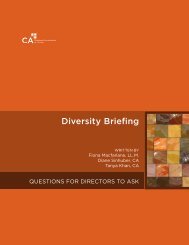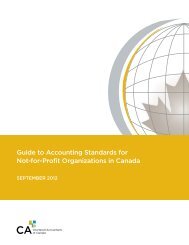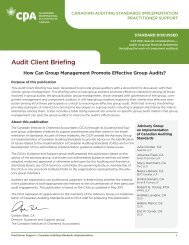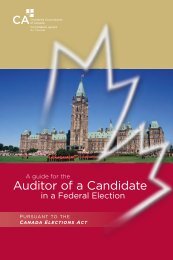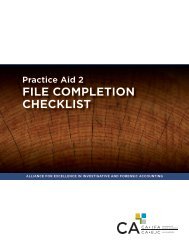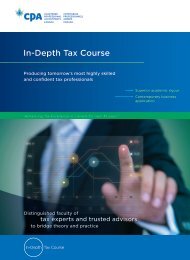20 Questions Directors of Not-for-Profit Organizations Should Ask ...
20 Questions Directors of Not-for-Profit Organizations Should Ask ...
20 Questions Directors of Not-for-Profit Organizations Should Ask ...
You also want an ePaper? Increase the reach of your titles
YUMPU automatically turns print PDFs into web optimized ePapers that Google loves.
<strong>20</strong> <strong>Questions</strong> <strong>Directors</strong> <strong>of</strong> <strong>Not</strong>-For-Pr<strong>of</strong>it <strong>Organizations</strong><br />
<strong>Should</strong> <strong>Ask</strong> about Board Recruitment, Development and Assessment<br />
Governance Assessment<br />
Once board members are selected and developed,<br />
governance assessment <strong>of</strong> the board, its<br />
committees and individual directors helps to ensure<br />
that continuous improvement becomes engrained<br />
and governance shortcomings are acted upon.<br />
In practice, board, committee and individual<br />
director per<strong>for</strong>mance are <strong>of</strong>ten already addressed<br />
in one or more ways:<br />
1. Board effectiveness may be the topic <strong>of</strong> a<br />
presentation by a governance advisor at a<br />
board retreat leading to discussion regarding<br />
the board’s per<strong>for</strong>mance relative to the best<br />
practices presented.<br />
2. Boards and committees may assess and<br />
improve specific practices and procedures<br />
when problems arise or a better approach is<br />
suggested.<br />
3. The governance committee reviews the<br />
per<strong>for</strong>mance <strong>of</strong> individual directors when<br />
considering them <strong>for</strong> re-nomination.<br />
4. Board and committee chairs observe the<br />
per<strong>for</strong>mance and contribution <strong>of</strong> individual<br />
directors and may:<br />
• provide in<strong>for</strong>mal feedback and mentoring<br />
to encourage those who contribute well<br />
and want to do better;<br />
• discuss attendance, participation and<br />
other issues with those who are undercontributing;<br />
and<br />
• provide input to the nomination process.<br />
These approaches can work well, particularly when<br />
the board is willing to examine its own per<strong>for</strong>mance,<br />
directors are candid and receptive, and chairs<br />
provide effective feedback. There is a risk, however,<br />
and it is human nature, that directors will avoid<br />
candid criticism <strong>of</strong> peers in order to preserve<br />
working relations, but will nonetheless provide input<br />
to the nominating process. In such cases, other<br />
directors may feel that the nomination process<br />
is secretive or unfairly punitive. This is unfair to<br />
directors who may not have received feedback nor<br />
had an opportunity to make necessary adjustments<br />
to their behaviour.<br />
For these and other reasons, an increasing number<br />
<strong>of</strong> organizations have established more <strong>for</strong>mal,<br />
accountable and transparent assessment processes<br />
which set out clear responsibilities and criteria,<br />
opportunities <strong>for</strong> participation, feedback, reporting<br />
and follow-up action.<br />
15








